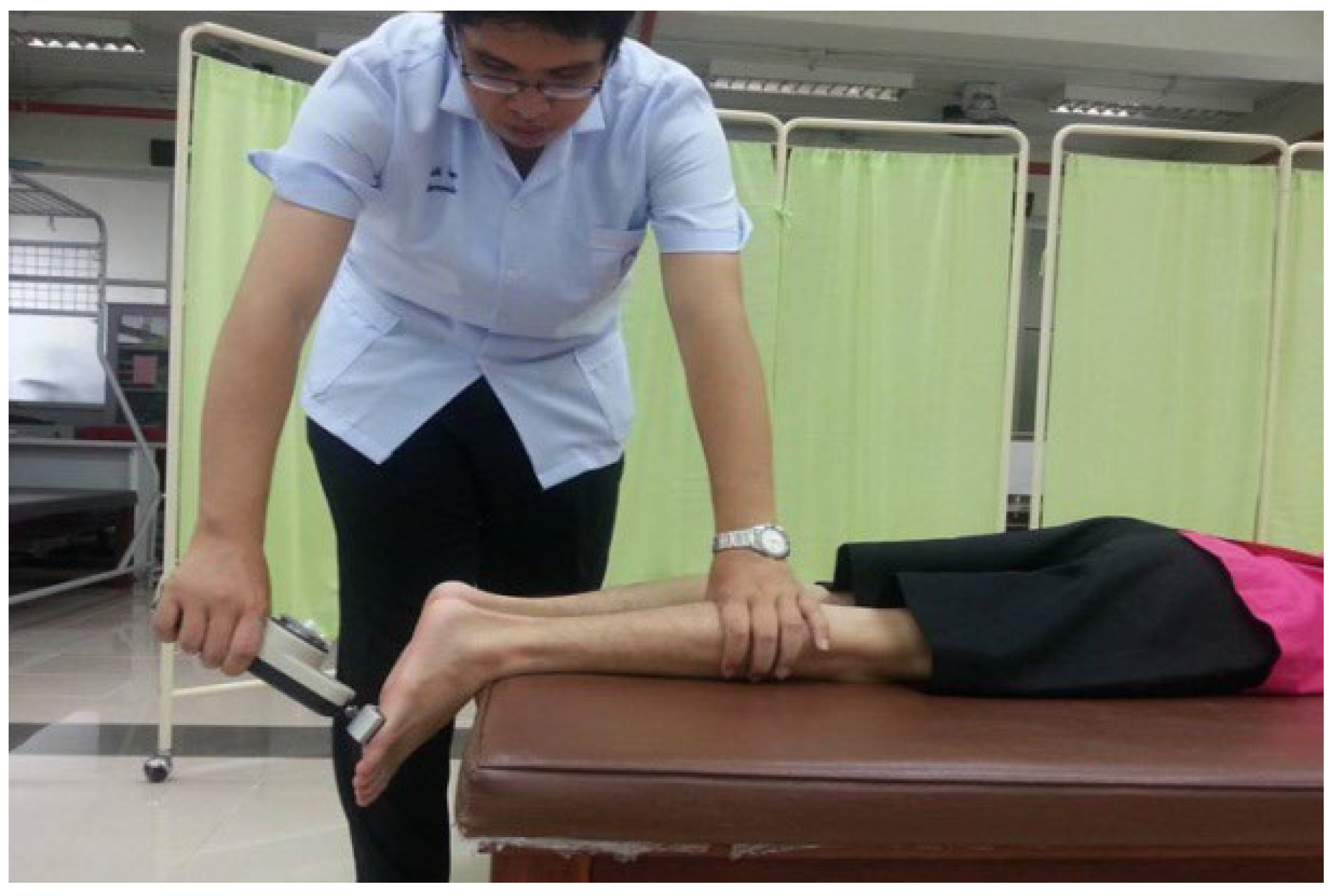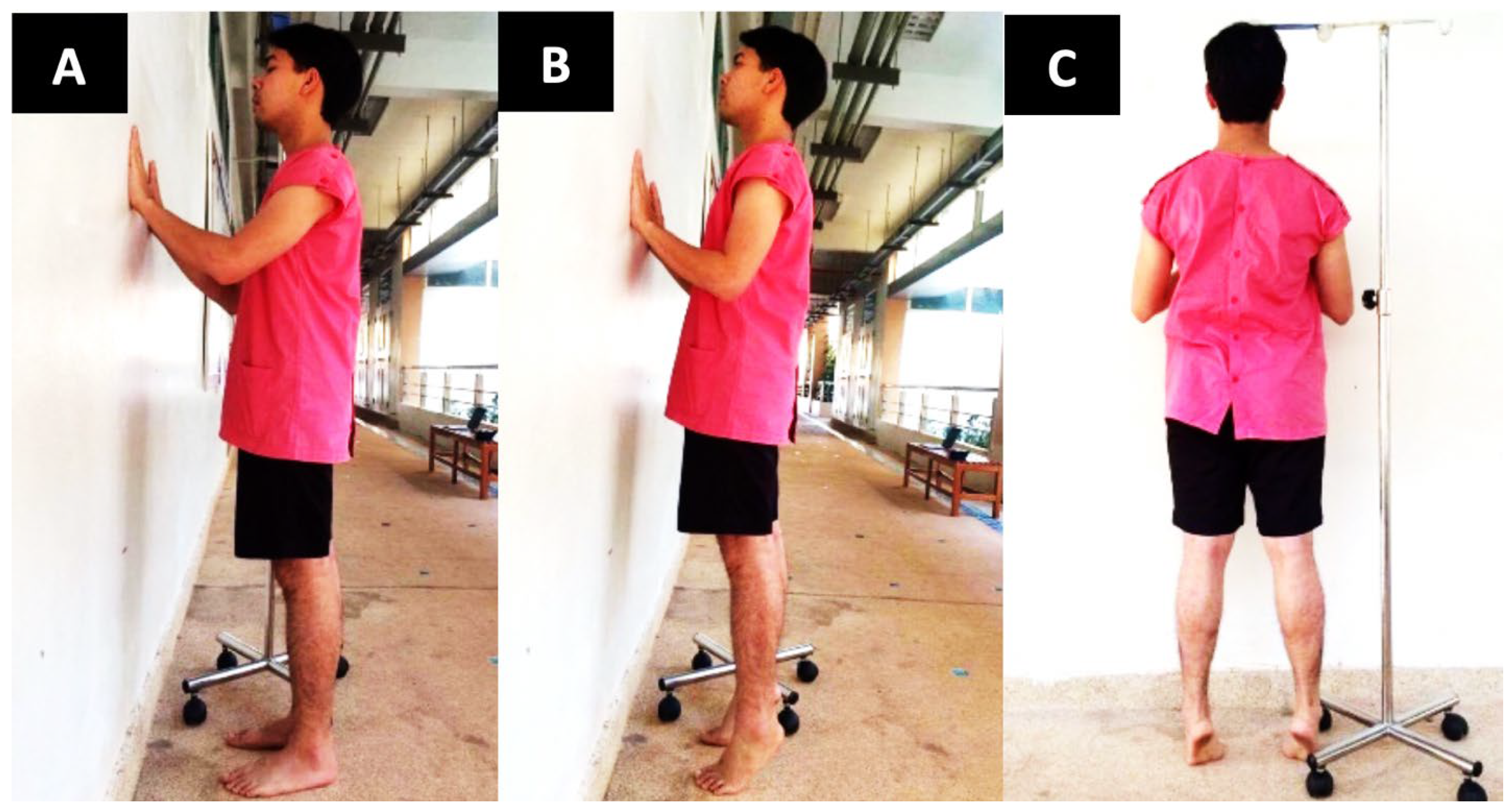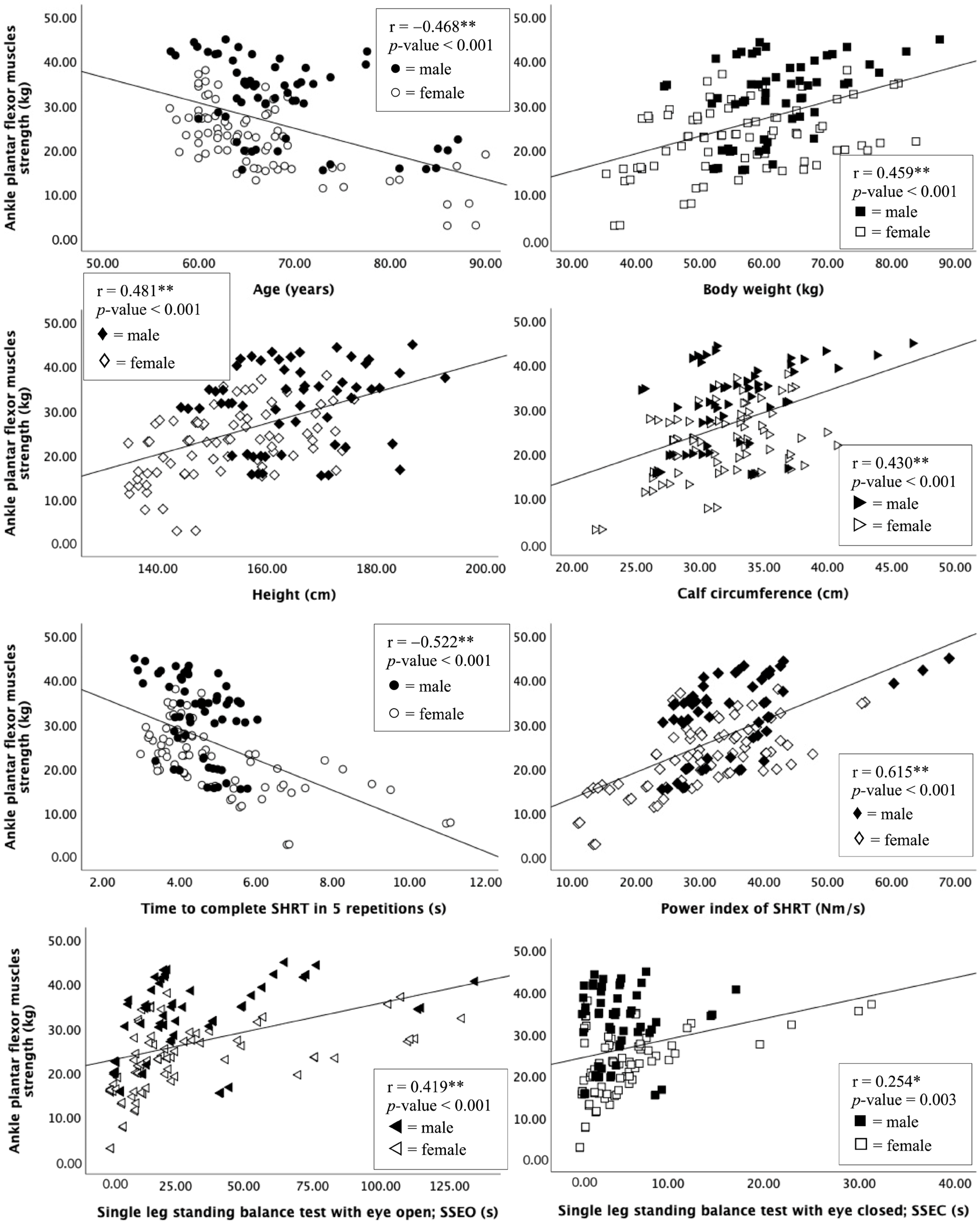Using a Standing Heel-Rise Test as a Predictor of Ankle Muscle Strength in the Elderly
Abstract
1. Introduction
2. Materials and Methods
2.1. Participants
2.2. Research Protocol
2.2.1. The Maximum Voluntary Contractions (MVCs) Test of the Ankle PF
2.2.2. Standing Heel-Rise Test (SHRT)
2.2.3. Single-Leg Standing Balance Test
2.3. Statistical Analysis
3. Results
4. Discussion
5. Conclusions
Author Contributions
Funding
Institutional Review Board Statement
Informed Consent Statement
Data Availability Statement
Acknowledgments
Conflicts of Interest
References
- Browne, J.; O’Hare, N. Review of the Different Methods for Assessing Standing Balance. Physiotherapy 2001, 87, 489–495. [Google Scholar] [CrossRef]
- Gomes, M.M.; Reis, J.G.; Carvalho, R.L.; Tanaka, E.H.; Hyppolito, M.A.; Abreu, D.C.C. Analysis of postural control and muscular performance in young and elderly women in different age groups. Braz. J. Phys. Ther. 2015, 19, 1–9. [Google Scholar] [PubMed]
- Jan, M.-H.; Chai, H.-M.; Lin, Y.-F.; Lin, J.C.-H.; Tsai, L.-Y.; Ou, Y.-C.; Lin, D.-H. Effects of age and sex on the results of an ankle plantar-flexor manual muscle test. Phys. Ther. 2005, 85, 1078–1084. [Google Scholar] [CrossRef] [PubMed]
- Flanagan, S.P.; Song, J.-E.; Wang, M.-Y.; Greendale, G.A.; Azen, S.P.; Salem, G.J. Biomechanics of the Heel-Raise Exercise. J. Aging Phys. Act. 2005, 13, 160–171. [Google Scholar] [CrossRef]
- van Uden, C.J.; van der Vleuten, C.J.; Kooloos, J.G.; Haenen, J.H.; Wollersheim, H. Gait and calf muscle endurance in patients with chronic venous insufficiency. Clin. Rehabil. 2005, 19, 339–344. [Google Scholar]
- Bok, S.-K.; Lee, T.H.; Lee, S.S. The effects of changes of ankle strength and range of motion according to aging on balance. Ann. Rehabil. Med. 2013, 37, 10–16. [Google Scholar] [CrossRef]
- Hashish, R.; Samarawickrame, S.D.; Wang, M.-Y.; Yu, S.S.-Y.; Salem, G.J. The association between unilateral heel-rise performance with static and dynamic balance in community dwelling older adults. Geriatr. Nurs. 2015, 36, 30–34. [Google Scholar] [CrossRef][Green Version]
- Henry, M.; Baudry, S.; Alberts, B.B.G.T.; Selen, L.P.J.; Medendorp, W.P.; Bollu, T.; Whitehead, S.C.; Prasad, N.; Walker, J.; Shyamkumar, N.; et al. Sensorimotor Integration in Human Postural Control. J. Neurophysiol. 2002, 88, 1097–1118. [Google Scholar]
- Gonçalves, G.H.; Sendín, F.A.; Serrão, P.R.M.d.S.; Selistre, L.F.A.; Petrella, M.; Carvalho, C.; Mattiello, S.M. Ankle strength impairments associated with knee osteoarthritis. Clin. Biomech. 2017, 46, 33–39. [Google Scholar] [CrossRef]
- Cattagni, T.; Scaglioni, G.; Laroche, D.; Gremeaux, V.; Martin, A. The involvement of ankle muscles in maintaining balance in the upright posture is higher in elderly fallers. Exp. Gerontol. 2016, 77, 38–45. [Google Scholar] [CrossRef]
- Shao, X.; Wang, Z.; Luan, L.; Sheng, Y.; Yu, R.; Pranata, A.; Adams, R.; Zhang, A.; Han, J. Impaired ankle inversion proprioception during walking is associated with fear of falling in older adults. Front. Aging Neurosci. 2022, 14, 946509. [Google Scholar] [CrossRef]
- Noreau, L.; Vachon, J. Comparison of three methods to assess muscular strength in individuals with spinal cord injury. Spinal Cord 1998, 36, 716–723. [Google Scholar] [PubMed]
- Bohannon, R.W.; Bohannon, D.C.R.W.; Corrigan, D.; Hislop, H.J.; Avers, D.; Brown, M.; Shahgholi, L.; Bengtson, K.A.; Bishop, A.T.; Shin, A.Y.; et al. A broad range of forces is encompassed by the maximum manual muscle test grade of five. Percept. Mot. Ski. 2000, 90, 747–750. [Google Scholar] [CrossRef] [PubMed]
- Martin, H.J.; Yule, V.; Syddall, H.E.; Dennison, E.M.; Cooper, C.; Aihie Sayer, A. Is hand-held dynamometry useful for the measurement of quadriceps strength in older people? A comparison with the gold standard Bodex dynamometry. Gerontology 2006, 52, 154–159. [Google Scholar] [CrossRef] [PubMed]
- Bohannon, R.W. Test-Retest Reliability of Hand-Held Dynamometry During a Single Session of Strength Assessment. Phys. Ther. 1986, 66, 206–209. [Google Scholar]
- Thomson, D.; Liston, M.; Gupta, A. Is the 10 metre walk test on sloped surfaces associated with age and physical activity in healthy adults? Eur. Rev. Aging Phys. Act. 2019, 16, 11. [Google Scholar] [CrossRef]
- Podsiadlo, D.; Richardson, S. The Timed “Up & Go”: A Test of Basic Functional Mobility for Frail Elderly Persons. J. Am. Geriatr. Soc. 1991, 39, 142–148. [Google Scholar]
- Suzuki, T.; Bean, J.F.; Fielding, R.A. Muscle Power of the Ankle Flexors Predicts Functional Performance in Community-Dwelling Older Women. J. Am. Geriatr. Soc. 2001, 49, 1161–1167. [Google Scholar] [CrossRef]
- Gross, M.; Stevenson, P.; Charette, S.; Pyka, G.; Marcus, R. Effect of muscle strength and movement speed on the biomechanics of rising from a chair in healthy elderly and young women. Gait Posture 1998, 8, 175–185. [Google Scholar] [CrossRef]
- McCarthy, E.K.; Horvat, M.A.; Holtsberg, P.A.; Wisenbaker, J.M. Repeated Chair Stands as a Measure of Lower Limb Strength in Sexagenarian Women. J. Gerontol. Ser. A 2004, 59, 1207–1212. [Google Scholar] [CrossRef]
- André, H.-I.; Carnide, F.; Borja, E.; Ramalho, F.; Santos-Rocha, R.; Veloso, A.P. Calf-raise senior: A new test for assessment of plantar flexor muscle strength in older adults: Protocol, validity, and reliability. Clin. Interv. Aging 2016, 11, 1661–1674. [Google Scholar]
- Hébert-Losier, K.; Wessman, C.; Alricsson, M.; Svantesson, U. Updated reliability and normative values for the standing heel-rise test in healthy adults. Physiotherapy 2017, 103, 446–452. [Google Scholar] [PubMed]
- Yocum, A.; McCoy, S.W.; Bjornson, K.F.; Mullens, P.; Burton, G.N. Reliability and Validity of the Standing Heel-Rise Test. Phys. Occup. Ther. Pediatr. 2010, 30, 190–204. [Google Scholar] [CrossRef] [PubMed]
- Tapanya, W.; Maharan, S.; Amput, P.; Sangkarit, N.; Suwannakul, B. The Influence of Knee Extensor and Ankle Plantar Flexor Strength on Single-Leg Standing Balance in Older Women. J. Funct. Morphol. Kinesiol. 2023, 8, 67. [Google Scholar] [CrossRef] [PubMed]
- Menz, H.B.; Morris, M.E.; Lord, S.R. Foot and Ankle Characteristics Associated With Impaired Balance and Functional Ability in Older People. J. Gerontol. A Biol. Sci. Med. Sci. 2005, 60, 1546–1552. [Google Scholar]
- Moraux, A.; Canal, A.; Ollivier, G.; Ledoux, I.; Doppler, V.; Payan, C.; Hogrel, J.-Y. Ankle dorsi- and plantar-flexion torques measured by dynamometry in healthy subjects from 5 to 80 years. BMC Musculoskelet. Disord. 2013, 14, 104. [Google Scholar]
- Spink, M.; Fotoohabadi, M.R.; Menz, H. Foot and Ankle Strength Assessment Using Hand-Held Dynamometry: Reliability and Age-Related Differences. Gerontology 2010, 56, 525–532. [Google Scholar]
- Halliday, D.; Resnick, R.; Walker, J. Fundamentals of Physics; Chapters 1–20; Wiley: New York, NY, USA, 2015; Volume 1. [Google Scholar]
- Takai, Y.; Ohta, M.; Akagi, R.; Kanehisa, H.; Kawakami, Y.; Fukunaga, T. Sit-to-stand Test to Evaluate Knee Extensor Muscle Size and Strength in the Elderly: A Novel Approach. J. Physiol. Anthr. 2009, 28, 123–128. [Google Scholar]
- Khanal, P.; He, L.; Stebbings, G.K.; Onambele-Pearson, G.L.; Degens, H.; Williams, A.G.; Thomis, M.; Morse, C.I. Static one-leg standing balance test as a screening tool for low muscle mass in healthy elderly women. Aging Clin. Exp. Res. 2021, 33, 1831–1839. [Google Scholar] [CrossRef]
- Walston, J.D. Sarcopenia in older adults. Curr. Opin. Rheumatol. 2012, 24, 623–627. [Google Scholar] [CrossRef]
- Senior, H.E.; Henwood, T.R.; Beller, E.M.; Mitchell, G.K.; Keogh, J.W. Prevalence and risk factors of sarcopenia among adults living in nursing homes. Maturitas 2015, 82, 418–423. [Google Scholar] [CrossRef] [PubMed]
- Mitchell, W.K.; Williams, J.; Atherton, P.; Larvin, M.; Lund, J.; Narici, M. Sarcopenia, Dynapenia, and the Impact of Advancing Age on Human Skeletal Muscle Size and Strength; a Quantitative Review. Front. Physiol. 2012, 3, 260. [Google Scholar] [CrossRef] [PubMed]
- Serra-Prat, M.; Palomera, E. Muscle Strength, Sarcopenia and Frailty Associations with Balance and Gait Parameters: A Cross-sectional Study. Eur. J. Geriatr. Gerontol. 2019, 1, 61–66. [Google Scholar]
- Makizako, H.; Shimada, H.; Doi, T.; Park, H.; Yoshida, D.; Uemura, K.; Tsutsumimoto, K.; Liu-Ambrose, T.; Suzuki, T. Poor balance and lower gray matter volume predict falls in older adults with mild cognitive impairment. BMC Neurol. 2013, 13, 102. [Google Scholar]
- Aveiro, M.C.; Driusso, P.; Dos Santos, J.G.; Kiyoto, V.D.; Oishi, J. Effects of a group-based exercise program on muscle strength and postural control among community-dwelling elderly women: A randomized-controlled trial. Rev. Bras. Geriatr. Gerontol. 2013, 16, 527–540. [Google Scholar]
- Hernández-Guillén, D.; Tolsada-Velasco, C.; Roig-Casasús, S.; Costa-Moreno, E.; Borja-De-Fuentes, I.; Blasco, J.-M. Association ankle function and balance in community-dwelling older adults. PLoS ONE 2021, 16, e0247885. [Google Scholar]
- Wang, Q.; Li, L.; Mao, M.; Sun, W.; Zhang, C.; Mao, D.; Song, Q. The relationships of postural stability with muscle strength and proprioception are different among older adults over and under 75 years of age. J. Exerc. Sci. Fit. 2022, 20, 328–334. [Google Scholar]
- Chung, C.-M.; Shin, S.; Lee, Y.; Lee, D.-Y. Determination of the Predictors with the Greatest Influence on Walking in the Elderly. Medicina 2022, 58, 1640. [Google Scholar] [CrossRef]
- Brach, J.S.; VanSwearingen, J.M. Interventions to Improve Walking in Older Adults. Curr. Transl. Geriatr. Exp. Gerontol. Rep. 2013, 2, 230–238. [Google Scholar] [CrossRef]
- Willemse, L.; Wouters, E.J.M.; Bronts, H.M.; Pisters, M.F.; Vanwanseele, B. The effect of interventions anticipated to improve plantar intrinsic foot muscle strength on fall-related dynamic function in adults: A systematic review. J. Foot Ankle Res. 2022, 15, 3. [Google Scholar]
- Laubach, K.J.L.; Long, A.; Jackson, K.; Laubach, L. A Home-based Exercise Program for the Foot and Ankle to Improve Balance, Muscle Performance and Flexibility in Community Dwelling Older Adults: A Pilot Study. Int. J. Phys. Med. Rehabil. 2013, 1, 83. [Google Scholar]
- Verdijk, L.B.; van Loon, L.J.C.; Meijer, K.; Savelberg, H. One-repetition maximum strength test represents a valid means to assess leg strength in vivo in humans. J. Sport. Sci. 2009, 27, 59–68. [Google Scholar]
- Mendoza, M.; Miller, R.G. Muscle Strength, Assessment of. In Encyclopedia of the Neurological Sciences; Aminoff, M.J., Daroff, R.B., Eds.; Academic Press: New York, NY, USA, 2003; pp. 279–285. [Google Scholar]
- Ross, M.D.; Fontenot, E. Test–Retest Reliability of the Standing Heel-Rise Test. J. Sport Rehabil. 2000, 9, 117–123. [Google Scholar] [CrossRef]
- Doherty, T.J. Invited Review: Aging and sarcopenia. J. Appl. Physiol. 2003, 95, 1717–1727. [Google Scholar] [PubMed]
- Glenmark, B.; Nilsson, M.; Gao, H.; Gustafsson, J.-Å.; Dahlman-Wright, K.; Westerblad, H. Difference in skeletal muscle function in males vs. females: Role of estrogen receptor-β. Am. J. Physiol.-Endocrinol. Metab. 2004, 287, E1125–E1131. [Google Scholar] [PubMed]
- McGowan, C.P.; Neptune, R.R.; Kram, R.; Franz, J.R.; Thelen, D.G.; Gordon, K.E.; Kinnaird, C.R.; Ferris, D.P. Independent effects of weight and mass on plantar flexor activity during walking: Implications for their contributions to body support and forward propulsion. J. Appl. Physiol. 2008, 105, 486–494. [Google Scholar]
- Bollinger, L.M. Potential contributions of skeletal muscle contractile dysfunction to altered biomechanics in obesity. Gait Posture 2017, 56, 100–107. [Google Scholar]
- de Oliveira, J.; Azzi, N.M.; Coelho, D.B.; Teixeira, L.A. Differential activation of the plantar flexor muscles in balance control across different feet orientations on the ground. J. Electromyogr. Kinesiol. 2022, 62, 102625. [Google Scholar]
- Gadeberg, P.; Andersen, H.; Jakobsen, J.; Baxter, J.R.; Piazza, S.J.; Holmbäck, A.M.; Porter, M.M.; Downham, D.; Andersen, J.L.; Lexell, J.; et al. Volume of ankle dorsiflexors and plantar flexors determined with stereological techniques. J. Appl. Physiol. 1999, 86, 1670–1675. [Google Scholar] [CrossRef]



| Variables (n = 121) | Mean ± SD |
|---|---|
| Gender (males/females) | 57/75 |
| Age (years) | 67.30 ± 7.60 |
| Mass (kg) | 58.60 ± 10.94 |
| Height (cm) | 157.99 ± 12.87 |
| Body mass index; BMI (kg/m2) | 23.38 ± 3.90 |
| Calf circumference (Centimeter) | 32.13 ± 4.10 |
| Ankle PF muscles strength (kg) | 26.47 ± 9.35 |
| Time to complete SHRT in 5 repetitions (s) | 4.75 ± 1.41 |
| Power index of SHRT (Nm/s) | 32.34 ± 9.81 |
| Single-leg standing balance test with eye open; SSEO (s) | 29.30 ± 30.02 |
| Single-leg standing balance test with eye closed; SSEC (s) | 5.29 ± 4.84 |
| Ankle PF Muscle Strength | ||
|---|---|---|
| Demographic data Variables | Gender | 0.479 ** (p-value < 0.001) |
| Age | −0.468 ** (p-value < 0.001) | |
| Weight | 0.459 ** (p-value < 0.001) | |
| Height | 0.481 ** (p-value < 0.001) | |
| BMI | 0.199 * (p-value = 0.022) | |
| Calf circumference | 0.430 ** (p-value < 0.001) | |
| Time to complete SHRT in 5 repetitions | −0.522 ** (p-value < 0.001) | |
| Power index of SHRT | 0.615 ** (p-value < 0.001) | |
| Single-leg standing balance test with eye open; SSEO | 0.419 ** (p-value < 0.001) | |
| Single-leg standing balance test with eye closed; SSEC | 0.254 * (p-value = 0.003) | |
| Model | Included Variables | β | p-Value | r | Adjusted r2 | SEE |
|---|---|---|---|---|---|---|
| 1 | Constant | 7.524 | 0.001 * | 0.615 | 0.374 | 7.399 |
| Power index of SHRT | 0.586 | <0.001 ** | ||||
| 2 | Constant | 7.069 | 0.001 * | 0.708 | 0.494 | 6.650 |
| Power index of SHRT | 0.510 | <0.001 ** | ||||
| Gender | 6.774 | <0.001 ** | ||||
| 3 | Constant | 42.427 | <0.001 ** | 0.783 | 0.604 | 5.881 |
| Power index of SHRT | 0.352 | <0.001 ** | ||||
| Gender | 8.290 | <0.001 ** | ||||
| Age | −0.459 | <0.001 ** | ||||
| 4 | Constant | 37.283 | <0.001 ** | 0.797 | 0.624 | 5.734 |
| Power index of SHRT | 0.325 | <0.001 ** | ||||
| Gender | 8.142 | <0.001 ** | ||||
| Age | −0.391 | <0.001 ** | ||||
| SSEO | 0.051 | 0.006 * | ||||
| 5 | Constant | 24.310 | 0.001 * | 0.816 | 0.653 | 5.507 |
| Power index of SHRT | 0.204 | 0.003 * | ||||
| Gender | 8.138 | <0.001 ** | ||||
| Age | −0.381 | <0.001 ** | ||||
| SSEO | 0.067 | <0.001 ** | ||||
| Calf circumference | 0.490 | 0.001 * |
Disclaimer/Publisher’s Note: The statements, opinions and data contained in all publications are solely those of the individual author(s) and contributor(s) and not of MDPI and/or the editor(s). MDPI and/or the editor(s) disclaim responsibility for any injury to people or property resulting from any ideas, methods, instructions or products referred to in the content. |
© 2023 by the authors. Licensee MDPI, Basel, Switzerland. This article is an open access article distributed under the terms and conditions of the Creative Commons Attribution (CC BY) license (https://creativecommons.org/licenses/by/4.0/).
Share and Cite
Tapanya, W.; Maharan, S.; Sangkarit, N.; Poncumhak, P.; Konsanit, S. Using a Standing Heel-Rise Test as a Predictor of Ankle Muscle Strength in the Elderly. Sports 2023, 11, 146. https://doi.org/10.3390/sports11080146
Tapanya W, Maharan S, Sangkarit N, Poncumhak P, Konsanit S. Using a Standing Heel-Rise Test as a Predictor of Ankle Muscle Strength in the Elderly. Sports. 2023; 11(8):146. https://doi.org/10.3390/sports11080146
Chicago/Turabian StyleTapanya, Weerasak, Sinthuporn Maharan, Noppharath Sangkarit, Puttipong Poncumhak, and Saisunee Konsanit. 2023. "Using a Standing Heel-Rise Test as a Predictor of Ankle Muscle Strength in the Elderly" Sports 11, no. 8: 146. https://doi.org/10.3390/sports11080146
APA StyleTapanya, W., Maharan, S., Sangkarit, N., Poncumhak, P., & Konsanit, S. (2023). Using a Standing Heel-Rise Test as a Predictor of Ankle Muscle Strength in the Elderly. Sports, 11(8), 146. https://doi.org/10.3390/sports11080146






